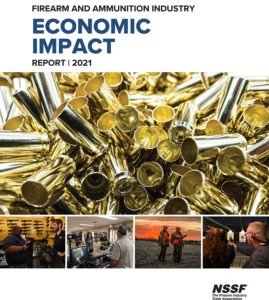Does The Nra Make Money From Gun Sales
Firearm and Ammunition Industry Economic Impact Report 2021
 This NSSF report details the significant economic impact the firearm and ammunition industry has on the nation's and each state's economy.
This NSSF report details the significant economic impact the firearm and ammunition industry has on the nation's and each state's economy.
The economic growth America's firearm and ammunition industry has experienced in recent years has been nothing short of remarkable. Over the past decade, the industry's growth has been driven by an unprecedented number of Americans choosing to exercise their fundamental right to keep and bear arms and purchase a firearm and ammunition.
NSSF, representing America's firearm and ammunition manufacturers, takes great pride in supporting wildlife conservation efforts. Noted in the economic impact report is the significant taxes paid by our industry to federal and state governments and the Pittman-Robertson excise tax the industry pays on the products it sells – this tax is the major source of wildlife conservation funding in America.
View Report
Our industry is proud to be one of the bright spots in this economy.
Use this map and take a look for yourself and see the impact we have nationally and on your home state.
The Firearm Industry Creates Jobs in America
United States companies that manufacture, distribute, and sell sporting firearms, ammunition, and supplies are an important part of the country's economy. Manufacturers of firearms, ammunition, and supplies, along with the companies that sell and distribute these products, provide well paying jobs in America and pay significant amounts in tax to the state and Federal governments.
Economic Impact of the Sporting Arms and Ammunition Industry in the United States
| Direct | Supplier | Induced | Total | |
|---|---|---|---|---|
| Jobs (FTE) | 153,414 | 78,217 | 110,699 | 342,330 |
| Wages | $7,135,393,100 | $5,904,867,200 | $6,271,277,400 | $19,311,537,700 |
| Economic Impact | $25,526,060,800 | $18,063,616,600 | $19,896,816,600 | $63,486,494,000 |
The Firearm & Ammunition Industry is an Important Part of America's Economy
Companies in the United States that manufacture, distribute, and sell firearms, ammunition, and hunting equipment employ as many as 153,414 people in the country and generate an additional 188,916 jobs in supplier and ancillary industries. These include jobs in supplying goods and services to manufacturers, distributors, and retailers, and those that depend on sales to workers in the firearms and ammunition industry. [1]
These are good jobs paying an average of $56,400 in wages and benefits. And today, every job is important. The United States currently has an unemployment rate of 6.71 percent. This means that there are already 10,779,000 people trying to find jobs in the nation and collecting unemployment benefits. [2]
The Economic Benefit of the Industry Spreads Throughout the Country
Not only does the manufacture and sale of firearms and hunting supplies create good jobs in the United States, but the industry also contributes to the economy as a whole. In fact, in 2020 the firearms and ammunition industry was responsible for as much as $63.49 billion in total economic activity in the country.
The broader economic impact flows throughout the economy, generating business for firms seemingly unrelated to firearms. Real people, with real jobs, working in industries as varied as banking, retail, accounting, metal working, even in printing, all depend on the firearms and ammunition industry for their livelihood.
The Country Also Benefits From the Taxes Paid By The Industry
Not only does the industry create jobs, it also generates sizeable tax revenues. In the United States, the industry and its employees pay over $6.99 billion in taxes including property, income, and sales based levies. [3]
Taxes Generated in the United States
| Tax Impact | Business Taxes | Excise Taxes |
|---|---|---|
| Federal Taxes | $4,054,260,100 | $665,253,000 |
| State Taxes | $2,931,471,500 | |
| Total Taxes | $6,985,731,600 | $665,253,000 |
View Report
1 John Dunham & Associates, New York, December 2020. Direct impacts include those jobs in firearms and ammunition manufacturers, as well as companies that manufacture products such as
ammunition holders and magazines, cases, decoys, game calls, holsters, hunting equipment, scopes, clay pigeons and targets. Direct impacts also include those resulting from the wholesale distribution
and retailing of these products.
2 The Bureau of Labor Statistics. Available online at: www.bls.gov/lau/home.htm. Data for Nov.-2020.
3 This is in addition to over $665.25 million in federal excise taxes.
Does The Nra Make Money From Gun Sales
Source: https://www.nssf.org/government-relations/impact/
Posted by: brownworseente.blogspot.com

0 Response to "Does The Nra Make Money From Gun Sales"
Post a Comment